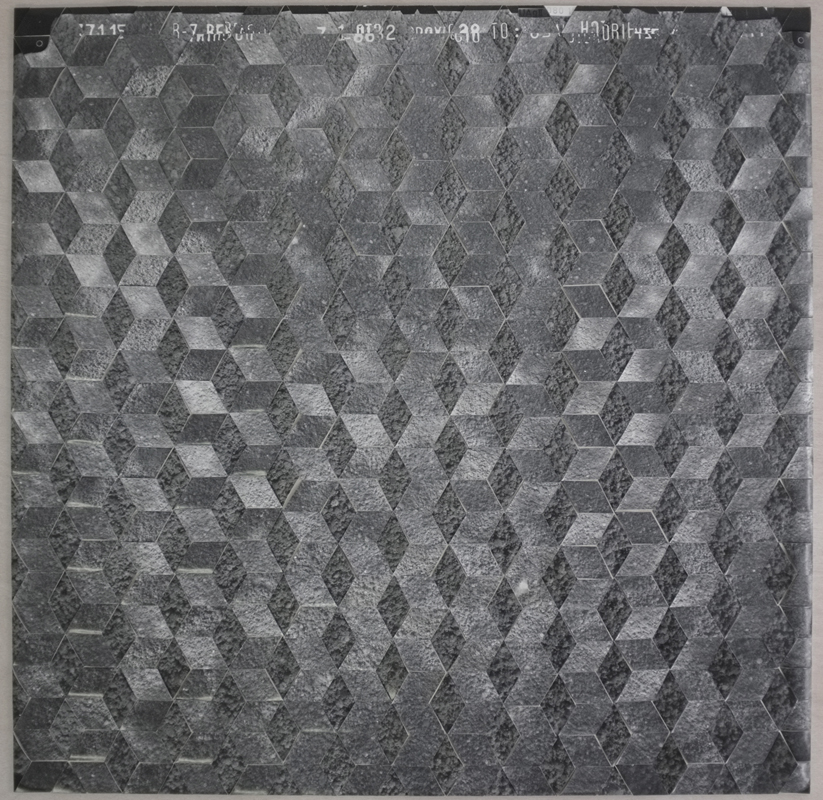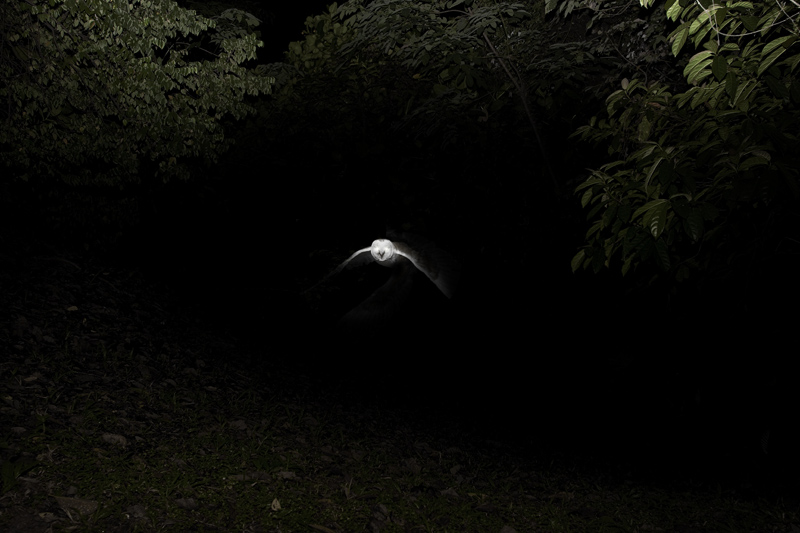
© » KADIST
Diane Severin Nguyen
To produce her photo and film works, Diane Severin Nguyen makes amalgam sculptures from found materials, both natural and synthetic. She captures these ephemeral constructions at close range, enlarging minute tensions. Nguyen uses transient, prosthetic lighting—the glow of sunset, an iPhone flash, battery-powered LEDs, fire—so that the camera intervenes moments before these temporary arrangements and their lighting change.

© » KADIST
Hoda Afshar
In the islands of the Strait of Hormuz off the southern coast of Iran, a distinctive local culture has emerged as the result of many centuries of cultural and economic exchange, the traces of which are seen not only in the material culture of these islands but also in the customs and beliefs of their inhabitants. Central to these is a belief in the existence of winds—generally thought of as harmful—that may possess a person, causing her to experience illness or disease, and a corresponding ritual practice involving incense, music and movement in which an hereditary cult leader speaks with the wind through the afflicted patient in one of many local or foreign tongues in order to negotiate its exit. While their exact origins are unclear, the existence of similar beliefs and practices in many African countries suggests that the cult may have been brought to the south of Iran from southeast Africa through the Arab slave trade.

© » KADIST
Sheroanawe Hakihiiwe
Perawesi / Estómago de animal / Stomach of animal by Sheroanawe Hakihiiwe exemplify his most abstract work, where he choses particular elements of a living organism to create his renditions. During the process of depuration of forms he develops a series of translations whose inception is the daily life and culture of his community, deep in the Amazon rainforest. The works reveal structures rather than shapes, organization rather than form, exposing a way of seeing where nature and culture are not mutually exclusive but manifesting simultaneously.

© » KADIST
Yo Daham
Yo Daham has been knitting, which he initially took up as a daily pastime, to produce objects that function as an incense burner by releasing smoke. His questioning of the nature of matter led to this unusual combination of knitting (typically considered a form of two-dimensional weaving) and an incense burner (an object traditionally used in rituals). Knitting is an act that requires unwinding a spool infinitely wrapped with thread and determining the form by applying force and pressure.

© » KADIST
Sheroanawe Hakihiiwe
Wateoma husipe / Larvas de oruga / Caterpillar larvae by Sheroanawe Hakihiiwe exemplify his most abstract work, where he choses particular elements of a living organism to create his renditions. During the process of depuration of forms he develops a series of translations whose inception is the daily life and culture of his community, deep in the Amazon rainforest. The works reveal structures rather than shapes, organization rather than form, exposing a way of seeing where nature and culture are not mutually exclusive but manifesting simultaneously.

© » KADIST
Abel Rodríguez
Abel Rodríguez’s precise, botanical illustrations are drawn from memory and knowledge acquired by oral traditions. They are the visions of someone who sees the potential of plants as food, material for dwellings and clothing, and for use in sacred rites. Terraza Alta V is part of a series of drawings that track the changing appearance and life of an area identified as Terraza Alta.

© » KADIST
Jes Fan
Jes Fan’s video work Xenophoria , as opposed to the term ‘xenophobia’, refers to a love of the foreign and is inspired by the name of a mysterious species of aquatic carrier shell. This creature, Xenophora pallidae, calcifies free-floating objects in the water to its spine, bringing foreign bodies into its own structure. Likewise, Xenophoria stages a delirious search for the melanin pigment – the molecule responsible for skin color – as it manifests in both human and non-human bodies.

© » KADIST
Leelee Chan
Blindfold Receptor (caterpillar-yellow) by Leelee Chan is inspired by the camouflaging nature of the peppered-moth caterpillar. In 1800s Europe, during the industrial revolution, light-colored moths evolved into a darker color after trees in their habitat darkened by the polluting soot. Today, due to rapid human changes to the environment, caterpillars can adapt even before they metamorphose into moths, mimicking the colour of the branches they inhabit.

© » KADIST
Laís Amaral
Drawing & Print (Drawing & Print)
Laís Amaral abstract paintings dialogue with the feminine power. Just like the flow of a river, Laís produces her paintings as a flux that emerges from within, an inner force that relates to all the women in her life, family, and ones who know the medicinal powers of nature; who are part of this feminine force latent in the earth. In order to discover elements about herself, Laís Amaral understands painting as a gesture of leakage.

© » KADIST
Adrien Missika
Adrien Missika follows in the footsteps of the Brazilian landscape architect and artist Roberto Burle Marx (1909-1994), a designer of gardens, parks and promenades who introduced modern landscape architecture to Brazil. Marx’s work is characterized by the use of native tropical vegetation as a structural element of design. He worked with Oscar Niemeyer and Lucio Costa, the architects of Brazilia, and with them, the tropical plant became a motif in urban architecture.

© » KADIST
Angela Su
Drawing & Print (Drawing & Print)
From afar, Chimeric Antibodies by Angela Su may look like scientific drawings or botanical illustrations. Yet, upon closer look, sexual organs and imagined human and plant elements start becoming recognizable, and realistic. Each intricate, large-scale drawing indeed mixes human body parts, machines and other organic constructions as they become intertwined and inseparable.

© » KADIST
Claudia Martínez Garay
escenario chacana by Claudia Martínez Garay is a sculptural work composed of a frame-like structure that contains a series of ceramic pieces. It references the Chakana, an Andean cross that encompasses the different levels of existence (known as Pachas) and sacred elements contained in the Indigenous cosmologies of the region. It often appears in the geometrical motifs of textiles and ceramics.

© » KADIST
Jessica Warboys
The ongoing “Sea Paintings” series is central to the practice of Jessica Warboys. The series plays with the notion of ritual, performance, nature and consequence. The artist realises her “Sea Paintings” on the Zennor coast, near St Ives, where she emerges the canvas in the seawater, allowing the waves and the wind to mix the raw mineral pigments that have been applied by hand to damp folded canvases.

© » KADIST
Calderón & Piñeros (La Decanatura)
In Centro Espacial Satelital de Colombia (Colombian Satellite Space Center) , Calderón & Piñeros (La Decanatura) play tribute to two “stunning” satellite antennas installed in the small municipality of Chocontá where, in 1970, the Space Communications Center of Colombia was inaugurated. That same year, the first antenna, responsible for the transmission (via microwave) of radio and telephone signals was put in place and eleven years later, the second antenna or Ground Station for International Communications would complete the complex known as Space Communications Center. Excursions to visit what became known as the “Satellite City of Colombia” were common for decades.

© » KADIST
Sergio Rojas Chaves
Más vale pájaro en mano que cien volando (A bird in the hand is worth more than two in the bush) is part of a larger series of pieces developed by Sergio Rojas Chaves in Honduras in 2018 that engages with tourism and in particular amateur-ornithologists that overrun the country in pursuit of the nation’s extreme diversity of bird species. The works include a performance in which artist Sergio Rojas Chaves, dressed like a bird, observes the ornithologists as if they too are birds, another work features an audio recording of amateur ornithologists imitating bird sounds in the jungle of Honduras. This series of photographs was taken during an amateur-ornithologist research trip.

© » KADIST
Zon Ito
This embroidery on fabric tackles the oneiric and the uncanny to bring about visions of the world. One can discern the methods of nihonga painting (the traditional Japanese style that renders landscape and forms out of subtle shadows), but Ito upsets the balance by destroying perspective. His work is staunchly non-narrative.

© » KADIST
Karrabing Film Collective
The Mermaids, or Aiden in Wonderland by Karrabing Film Collective is a surreal exploration of Western toxic contamination, capitalism, and human and non-human life. Set in a land and seascape poisoned by capitalism where only Aboriginals can survive long periods outdoors, the film tells the story of a young Indigenous man, Aiden, taken away when he was just a baby to be a part of a medical experiment to save the white race. He is then released back into the world to his family.

© » KADIST
Lucia Madriz
In her geometric paintings on wood panel, Madriz employs the Fibonacci numbers to illustrate, in simplified form, the pattern of natural plant growth—beginning from a single stem, and growing exponentially, rationally, and efficiently outward from there. Tinting the underlying wood but not covering it, Madriz’s delicate cubes seem to hover on the surface of the warm wood surfaces, drawing more attention to the grain and its own natural pattern. Always drawing the attention back to the natural world, Madriz’s multimedia works aim to reassert the natural, and our own links to it.
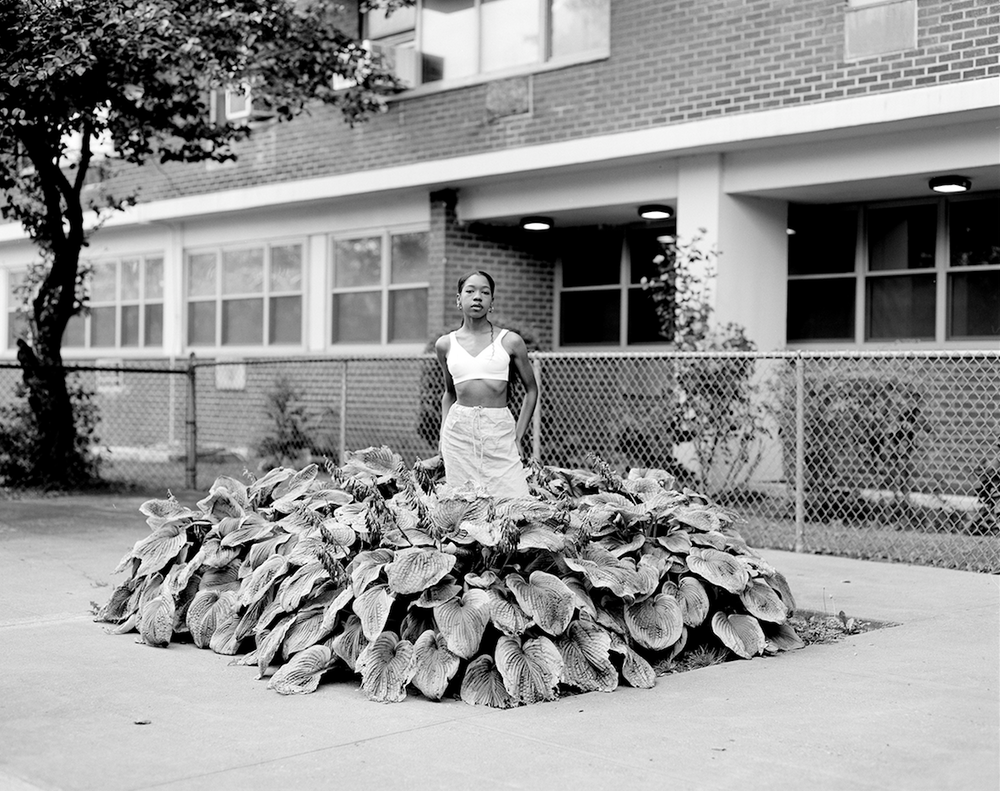
© » KADIST
Chanell Stone
Natura Negra , which translates to “Black Nature”, is a black-and-white photographic series by Chanell Stone that explores the connection between the Black body and nature within man-made environments. The series features a compilation of environmental portraits staged in urban “forests” that explore the notion of “holding space” within one’s immediate environment. Each image depicts an effort to reclaim and reconnect with the earth, even in spaces of compartmentalized nature like backyard gardens, flora intended as urban beautification, and lush public spaces.

© » KADIST
Chikako Yamashiro
The film installation Mud Man by Chikako Yamashiro is set on Okinawa and South Korea’s Jeju Islands, two locations at the center of local controversies surrounding the presence of the United States military. Japanese and Korean languages are mixed (a combination of unclear Japanese — Uchinaaguchi , fragments and mumbles in Korean and onomatopoeic sound effects to complement the narration), and the landscape of the two islands (Okinawa and Jeju Island) juxtaposed. The film tells the story of a community visited by bird droppings that resemble clumps of mud falling from the sky.

© » KADIST
Jakrawal Nilthamrong
Invalid Throne by Jakrawal Nilthamrong is a 35mm film that searches the protagonist Kamjorn Sankwan’s memory and connection with the land he grew up in. Using Nithamrong’s cinematic language of visual representations and soundscapes without narration, he highlights a non-human-centered view to meditate upon and reveal the sublime and unspoiled natural landscape ? as Nilthamrong states: “in the middle of nature where no man has claimed ownership”.
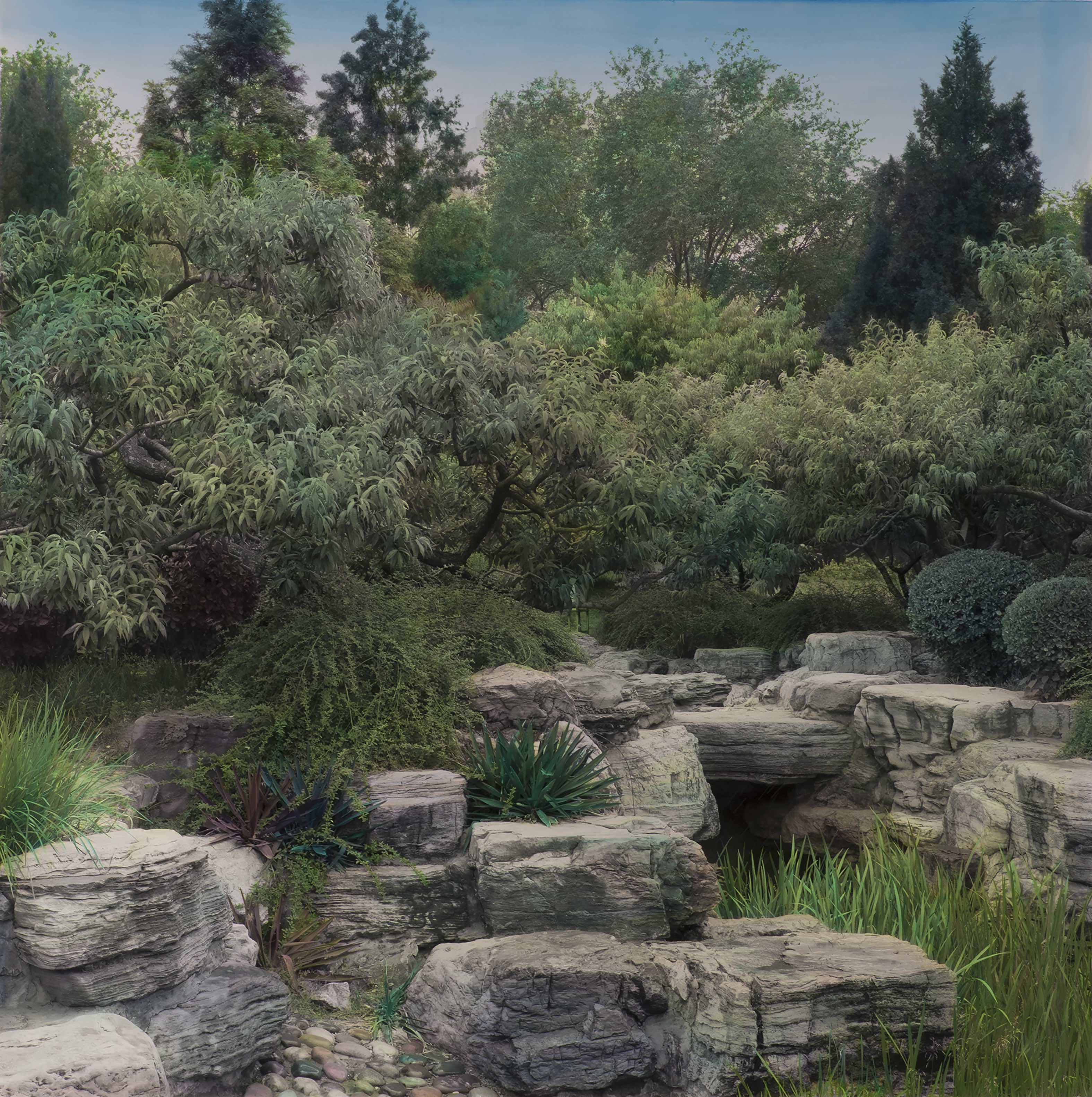
© » KADIST
Shi Guowei
Through a hand-painting process, Shi Guowei created Manufactured Landscape . At first glance, the painting appears from afar as a landscape photograph. Yet, upon closer attention, the work reveals itself as a landscape painting thoroughly hand-colored by the artist onto a photograph.

© » KADIST
Jakob Kudsk Steensen
Advanced Technology (Advanced Technology)
RE-ANIMATED by Jakob Kudsk Steensen revolves around the haunting sound of the Kauai’O’o, a bird that became extinct in the year of Steensen’s birth. Its mating call, recorded and circulated on YouTube, where it has attracted hundreds of thousands of views and thousands of comments from viewers who felt the need to share their own emotional connection with this creature. For Steensen, the video exemplifies the way in which digital media experiences can serve as a memorial for a disappearing natural world, and how they can activate deeply felt connections with nonhuman creatures.
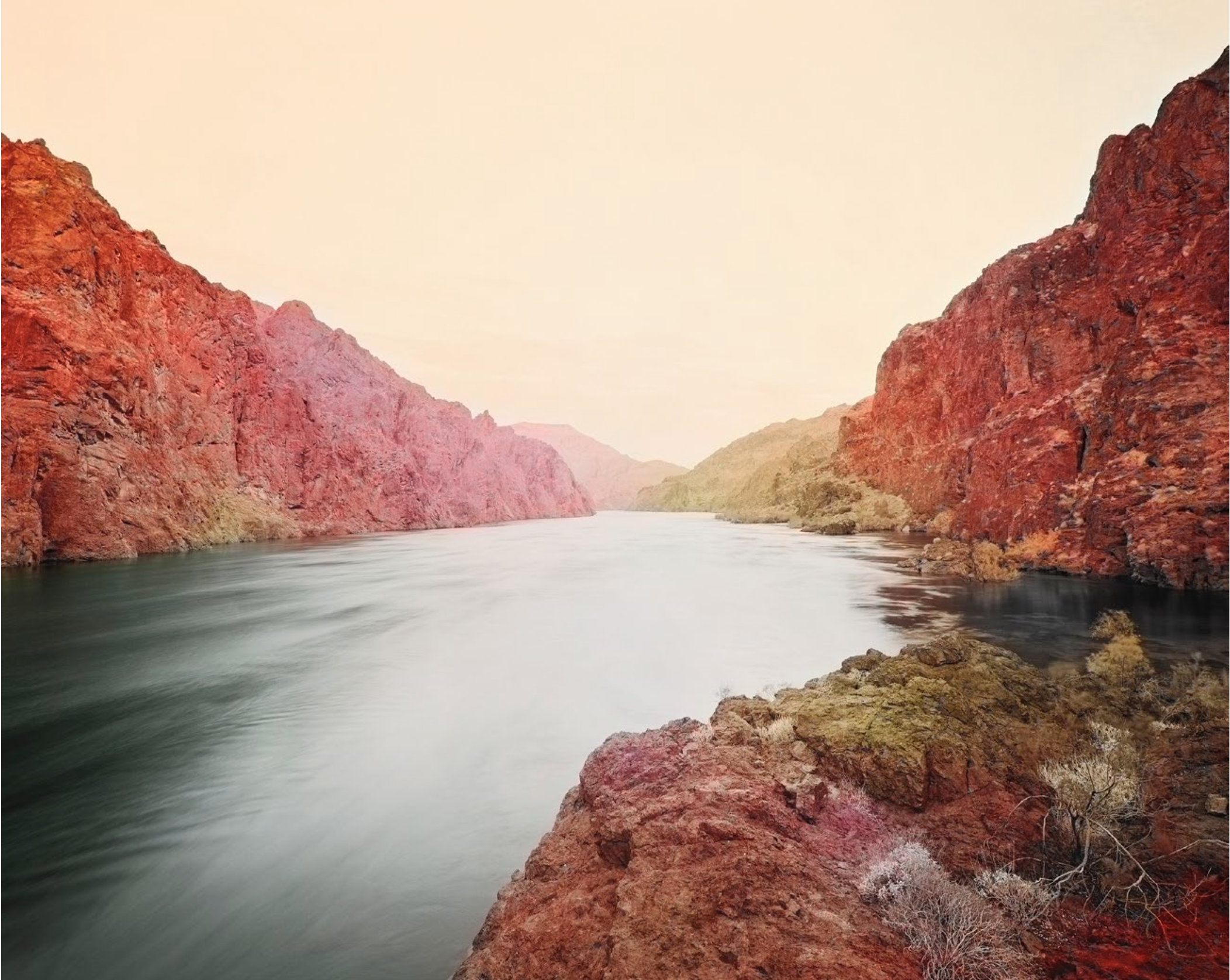
© » KADIST
Trevor Paglen
The Black Canyon Deep Semantic Image Segments by Trevor Paglen merges traditional American landscape photography (sometimes referred as ‘frontier photography’ for sites located in the American West) with artificial intelligence and other technological advances such as computer vision. In order to take this photograph, Paglen traveled to the Black Canyon, south of the Hoover Dam. Only accessible by water, Paglen piloted a boat up the Colorado river into the canyon.

© » KADIST
Antonio Pichillá
Wind by Antonio Pichillá is a textile piece depicting the glyph that represents the element wind in the Mayan tradition. It is woven in the four colors of each of the cardinal points which, together, symbolize the entire universe. It is woven mostly with knots that the artist refers to as a “bond between two or more systems that also represents a closure […] the knot in the throat that submerges the voice.” This piece, like other works in Pichillá’s practice, is an attempt to reconcile the Maya Tz’utujil symbolic tradition with Western art historical categories and practices.
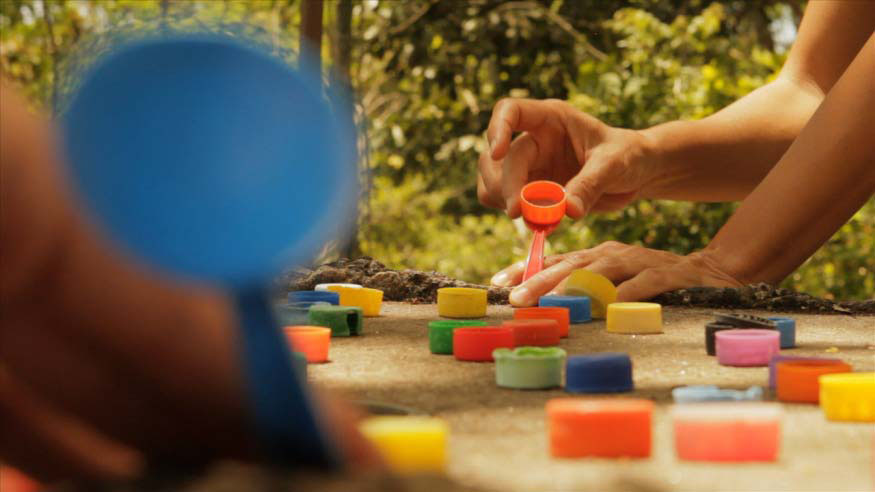
© » KADIST
Donna Conlon and Jonathan Harker
In Tapitapultas (2012), Donna Conlon and Jonathan Harker comment on mass consumerism and pollution by way of a game they invented. The artists used disposable spoons as catapults to shoot thousands of plastic bottle caps at a hole in a concrete platform. The platform was once part of a U. S. military installation in the Panama Canal Zone, and it is now an observation deck in a nature park.

© » KADIST
Federico Herrero
Federico Herrero’s energetic paintings reflect his experiences on the streets of his native San José, Costa Rica, and in the surrounding tropical landscape. Rooted in Central American folklore, politics, and culture, his works often move beyond the canvas onto the wall or into the streets. In Á rbol y Pelicao (Tree and Pelican, 2009), a tree with cartoonlike creatures drawn in pen beside it emerges from a field of bright swaths of color.

© » KADIST
Paul Kos
Taking its title from the eponymous mythological creature—famously featured as sea nymphs in Homer’s Odyssey. Sirens exist in literature across many cultures including Ancient Greece and India, described as part bird and part woman, or like a mermaid. They were said to charm men by their song, and, having first lulled them to sleep, tear them to pieces.

© » KADIST
Diana Thater
In Perpetual Motion (2005) the seemingly erratic flight of the bright orange Monarch butterfly—filmed in its winter habitat of Michoacán, Mexico—is intensified by the artist’s editing in which frames are randomly dropped and the film is sped up. As a result, the butterflies become hyper-real and animated in appearance. The manipulated footage is presented in a video wall of nine monitors, where the butterflies flit from screen to screen, in a room bathed in vivid orange light.
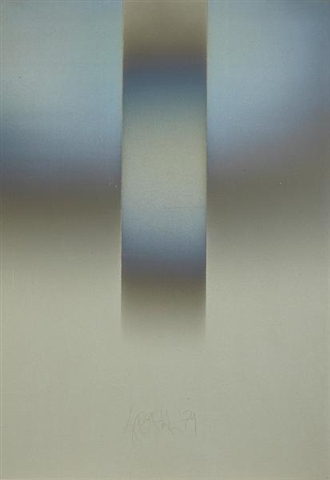
© » KADIST
Larry Bell
Drawing & Print (Drawing & Print)
Like many of Larry Bell’s works, VFGY9 deals primarily with the viewer’s experience of sight. The blocks resemble a stone carving, or slabs of wood shaped into a simple organic composition whose overall sheen is varied through a thin layer of aluminum vapor. Yet, the real material of Bell’s piece is actually light, formed within the viewer’s eye into masses as present as stone.
Diane Severin Nguyen
Diane Severin Nguyen collects found objects and organic matter to craft the images in her photographs and video works...
Sheroanawe Hakihiiwe
Sheroanawe Hakihiiwe is a Yanomami artist who lives and works in Upper Orinoco, at the Venezuelan side of the Amazon rainforest...
Jakrawal Nilthamrong
Jakrawal Nilthamrong is a Thai artist and filmmaker who came to prominence for his unconventional approach to filmmaking...
Chikako Yamashiro
Chikako Yamashiro engages with political and social histoires of Okinawa to create haunting works drawing on oral accounts...
Diana Thater
A pioneer of video and film installations for over a decade, Diana Thater’s works explore the nature and possibilities of moving-image media...
Larry Bell
- location: Venice, California
- year born: 1939
- gender: male
- nationality: American
- home town: Chicago, Illinois
Lucia Madriz
Born in Costa Rica and living in Germany, artist Lucía Madriz has a global perspective...
Trevor Paglen
Trevor Paglen’s work combines the knowledge-base of artist, geographer and activist...
Yo Daham
Yo Daham is a self-taught artist who has learnt from close exchanges with a group of artists in Seoul since early 2000...
Jessica Warboys
Employing a variety of media including film, sculpture, ceramic, photography, found objects and sea paintings, Jessica Warboys (b...
Yosuke Takeda
Yosuke Takeda started from experimenting with darkroom photography production and he shifted over to digital photography, aware that photographic film and paper were becoming obsolete...
Tanatchai Bandasak
Artist Tanatchai Bandasak began his career as a filmmaker, however following his studies at art school in France, he began exploring installation and sculptural strategies for presenting moving images...
Jakob Kudsk Steensen
Jakob Kudsk Steensen employs a formally rigorous approach to creating multi-layered VR environments that engage with the contemporary issue of extinction...
Jes Fan
Jes Fan is a Brooklyn-based artist born in Canada and raised in Hong Kong...
Sofia Crespo
Since 2018, Sofia Crespo has been working on what she terms “artificial natural history”...
Karrabing Film Collective
Karrabing Film Collective is an indigenous media group consisting of over 30 members, bringing together Aboriginal filmmakers from Australia’s Northern Territory...
Angela Su
Angela Su’s practice is derived from her two divergent backgrounds–she received a degree in biochemistry in Canada before pursuing visual arts...
Chanell Stone
Chanell Stone’s practice explores what she describes as the “re-naturing” of the Black body to the American landscape—an act that aims to complicate and sublimate the history of American slavery into a reimagined relationship between African Americans and the earth...
Adrien Missika
Adrien Missika (1981, Paris, France) studied and developed his career in Lausanne where he founded 1m3 artspace...
Zon Ito
Zon Ito was born in 1971 in Osaka...
Shi Guowei
Shi Guowei is concerned with notions of historical and cultural traditions as they relate to current socio-political issues...
Rometti Costales
Rometti Costales is an artistic collaboration between Julia Rometti and Victor Costales that began in 2007...
Federico Herrero
- location: San Jose, Costa Rica
- year born: 1978
- gender: male
- nationality: Costa Rican
- home town: San Jose, Costa Rica
Leelee Chan
Working in sculpture, Leelee Chan’s visual vocabulary reflects her subjective experience of the extreme urbanization in Hong Kong by proposing a dialogue between concrete materiality, found in heavy industry, and poetics found in ceramics, and its cultural archaeology in millinery Chinese history...
Hoda Afshar
At the intersection of conceptual, staged and documentary image-making, Hoda Afshar’s artistic practice explores the representation of gender, marginality and displacement...
Enrique Ramirez
- year born: 1979
- gender: male
- nationality: Chilean
- home town: Santiago, Chile
Paul Kos
- location: San Francisco, California
- year born: 1942
- gender: male
- nationality: American
Donna Conlon and Jonathan Harker
- location: Panama City, Panama
- year born: 1966
- nationality: American and Ecuadorian
Sergio Rojas Chaves
Sergio Rojas Chaves’s work focuses on contemporary depictions of animals and of plants and affective approaches to biology...
-
1970-1979
Larry Bell
Drawing & Print
1979(Drawing & Print) Like many of Larry Bell’s works, VFGY9 deals primarily with the viewer’s experience of sight...
-
2000-2009
Jean-Luc Moulène
2004It rains, Paris, 1st July 2000 , which could be the refrain of a song, is the title of a photograph of a minimal moment, the vision of a Parisian pedestrian, a cut flower lying on the pavement covered in rain drops...
Diana Thater
2005In Perpetual Motion (2005) the seemingly erratic flight of the bright orange Monarch butterfly—filmed in its winter habitat of Michoacán, Mexico—is intensified by the artist’s editing in which frames are randomly dropped and the film is sped up...
Federico Herrero
2009Federico Herrero’s energetic paintings reflect his experiences on the streets of his native San José, Costa Rica, and in the surrounding tropical landscape...
-
2010-2019
Angela Su
Drawing & Print
2011(Drawing & Print) From afar, Chimeric Antibodies by Angela Su may look like scientific drawings or botanical illustrations...
Donna Conlon and Jonathan Harker
2012In Tapitapultas (2012), Donna Conlon and Jonathan Harker comment on mass consumerism and pollution by way of a game they invented...
Adrien Missika
2013Adrien Missika follows in the footsteps of the Brazilian landscape architect and artist Roberto Burle Marx (1909-1994), a designer of gardens, parks and promenades who introduced modern landscape architecture to Brazil...
Jessica Warboys
2013The ongoing “Sea Paintings” series is central to the practice of Jessica Warboys...
Rometti Costales
Drawing & Print
2013(Drawing & Print) The three cut-outs are made of three aerial photographs coming from the archives of the Ecuadorian Military Geographic Institute...
Lucia Madriz
2014In her geometric paintings on wood panel, Madriz employs the Fibonacci numbers to illustrate, in simplified form, the pattern of natural plant growth—beginning from a single stem, and growing exponentially, rationally, and efficiently outward from there...
Yosuke Takeda
2014Yosuke Takeda gives the viewer brightly colored views, each of which he has searched out and patiently waited for...
Calderón & Piñeros (La Decanatura)
2015In Centro Espacial Satelital de Colombia (Colombian Satellite Space Center) , Calderón & Piñeros (La Decanatura) play tribute to two “stunning” satellite antennas installed in the small municipality of Chocontá where, in 1970, the Space Communications Center of Colombia was inaugurated...
Antonio Pichillá
2017Wind by Antonio Pichillá is a textile piece depicting the glyph that represents the element wind in the Mayan tradition...
Chikako Yamashiro
2017The film installation Mud Man by Chikako Yamashiro is set on Okinawa and South Korea’s Jeju Islands, two locations at the center of local controversies surrounding the presence of the United States military...
Jakob Kudsk Steensen
Advanced Technology
2018(Advanced Technology) RE-ANIMATED by Jakob Kudsk Steensen revolves around the haunting sound of the Kauai’O’o, a bird that became extinct in the year of Steensen’s birth...
Sergio Rojas Chaves
2018Más vale pájaro en mano que cien volando (A bird in the hand is worth more than two in the bush) is part of a larger series of pieces developed by Sergio Rojas Chaves in Honduras in 2018 that engages with tourism and in particular amateur-ornithologists that overrun the country in pursuit of the nation’s extreme diversity of bird species...
Karrabing Film Collective
2018The Mermaids, or Aiden in Wonderland by Karrabing Film Collective is a surreal exploration of Western toxic contamination, capitalism, and human and non-human life...
Jakrawal Nilthamrong
2018Invalid Throne by Jakrawal Nilthamrong is a 35mm film that searches the protagonist Kamjorn Sankwan’s memory and connection with the land he grew up in...
Abel Rodríguez
2018Abel Rodríguez’s precise, botanical illustrations are drawn from memory and knowledge acquired by oral traditions...
Diane Severin Nguyen
2019To produce her photo and film works, Diane Severin Nguyen makes amalgam sculptures from found materials, both natural and synthetic...
Sheroanawe Hakihiiwe
2019Perawesi / Estómago de animal / Stomach of animal by Sheroanawe Hakihiiwe exemplify his most abstract work, where he choses particular elements of a living organism to create his renditions...
Claudia Martínez Garay
2019escenario chacana by Claudia Martínez Garay is a sculptural work composed of a frame-like structure that contains a series of ceramic pieces...
Sheroanawe Hakihiiwe
2019Wateoma husipe / Larvas de oruga / Caterpillar larvae by Sheroanawe Hakihiiwe exemplify his most abstract work, where he choses particular elements of a living organism to create his renditions...
Leelee Chan
2019Blindfold Receptor (caterpillar-yellow) by Leelee Chan is inspired by the camouflaging nature of the peppered-moth caterpillar...
Chanell Stone
2019Natura Negra , which translates to “Black Nature”, is a black-and-white photographic series by Chanell Stone that explores the connection between the Black body and nature within man-made environments...
Enrique Ramirez
2019Enrique Ramirez’s La Memoria Verde is a work of poetry, politics, and memory created in response to the curatorial statement for the 13th Havana Biennial in 2019, The Construction of the Possible ...
Tanatchai Bandasak
2019Central Region by Tanatchai Bandasak is a meditation on materiality and time-based media centres on the mysterious, prehistoric ‘standing stones’ of Hintang in Northern Laos: little-studied megaliths which have survived thousands of years of political change and the cataclysmic carpet-bombing of Laos by the United States during the Cold War...
-
2020-2029
Trevor Paglen
2020The Black Canyon Deep Semantic Image Segments by Trevor Paglen merges traditional American landscape photography (sometimes referred as ‘frontier photography’ for sites located in the American West) with artificial intelligence and other technological advances such as computer vision...
Diane Severin Nguyen
2020To produce her photo and film works, Diane Severin Nguyen makes amalgam sculptures from found materials, both natural and synthetic...
Hoda Afshar
2022In the islands of the Strait of Hormuz off the southern coast of Iran, a distinctive local culture has emerged as the result of many centuries of cultural and economic exchange, the traces of which are seen not only in the material culture of these islands but also in the customs and beliefs of their inhabitants...
Laís Amaral
Drawing & Print
2022(Drawing & Print) Laís Amaral abstract paintings dialogue with the feminine power...
Sofia Crespo
2023This short looped-video NFT Invertebrate Interactions by Sofia Crespo aims to capture generated impressions of diatoms...





